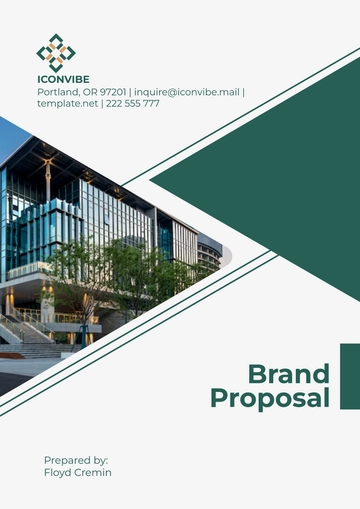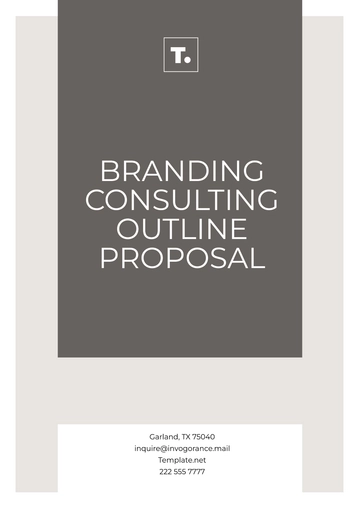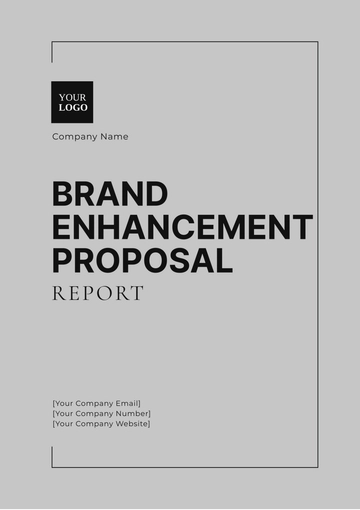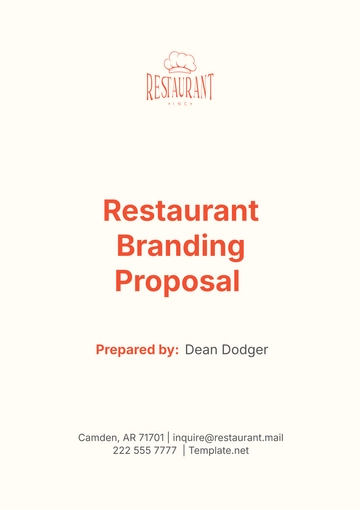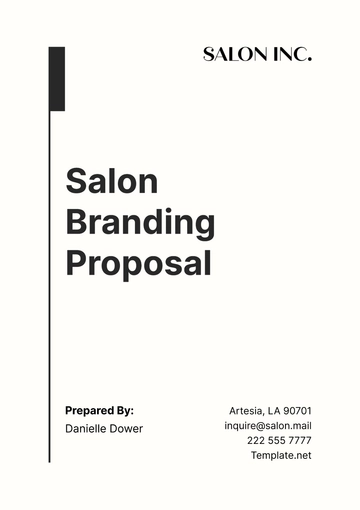Free Complete Brand Development Advertising Proposal
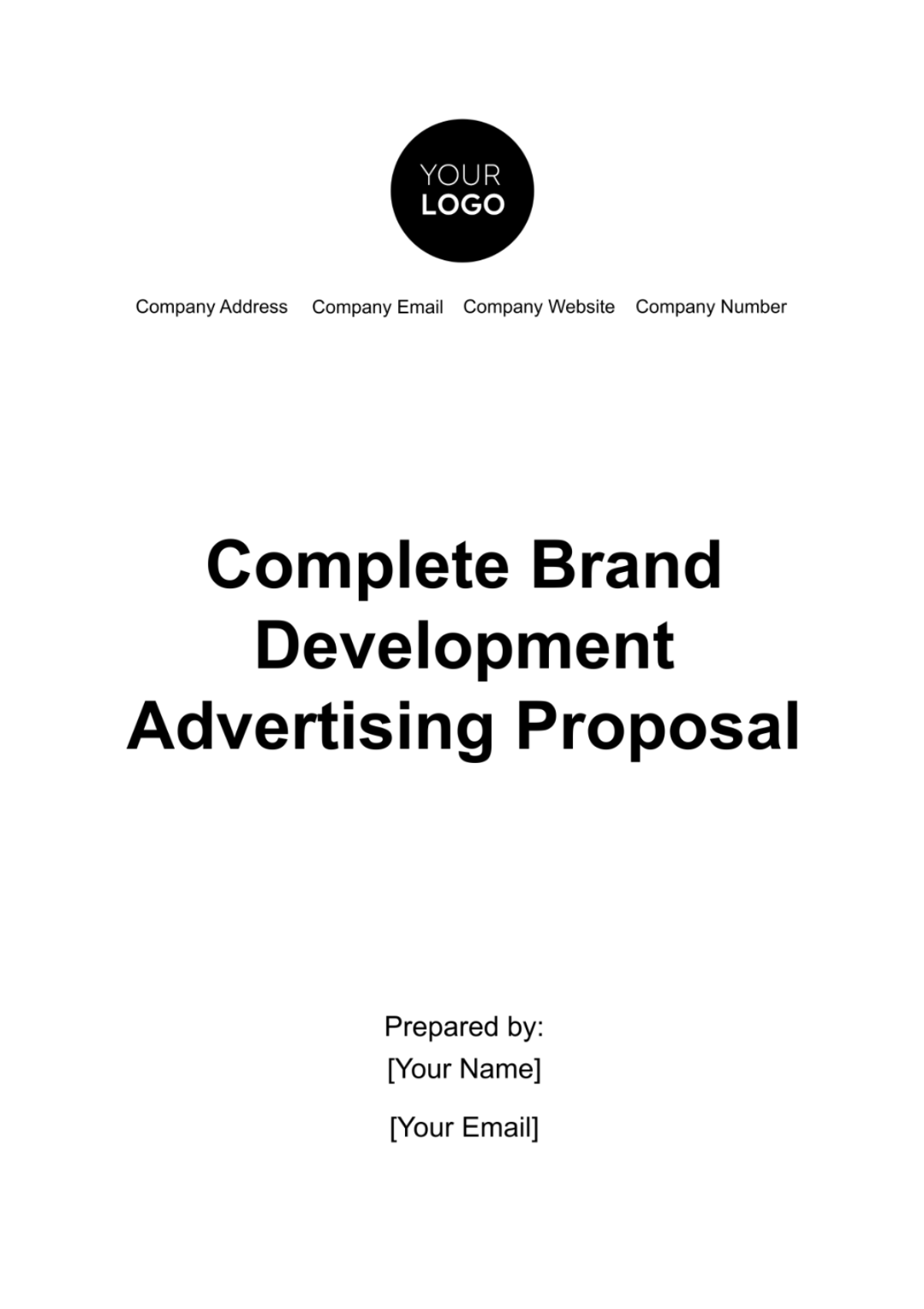
I. Introduction
[Your Company Name] stands at the forefront of its industry with this brand development strategy. Our proposal is meticulously crafted to enhance your brand's visibility, resonate with your target audience, and drive impactful market engagement.
II. Executive Summary
This summary highlights our targeted objectives, innovative strategies, and the anticipated impactful outcomes of our collaborative brand elevation efforts.
A. Overview: A strategic blueprint to redefine [Your Company Name]'s brand narrative and engagement.
B. Objectives: Aiming to catapult brand awareness, engagement, and loyalty to new heights.
C. Strategies: Integrating cutting-edge digital techniques with traditional media for maximum impact.
III. Brand Analysis
Gain insights into your current market positioning and untapped potential. Our comprehensive analysis will map out [Your Company Name]'s strengths, weaknesses, and opportunities within the dynamic market landscape.
A. Current Positioning
This assessment is critical in understanding the brand's existing market share, reputation, and overall visibility. It encompasses the identification of the brand’s unique selling proposition (USP) and the value proposition that differentiates it from competitors. By analyzing current positioning, we gain insights into the brand's effectiveness in communicating its message and fulfilling customer expectations.
This element also includes assessing the brand's visual identity, including logo, color scheme, and overall aesthetics, and how these elements resonate with the intended audience. Current positioning extends to the evaluation of marketing strategies and the effectiveness of previous advertising campaigns. Understanding the current positioning provides a baseline from which to measure future growth and success, helping to guide strategic decisions in the brand development process.
B. Strengths and Weaknesses
Analyzing a brand's strengths and weaknesses involves an internal review, focusing on what [Your Company Name] does best and areas where it may be lacking. Strengths could include a wide range of factors such as a loyal customer base, a strong brand image, innovative products or services, robust financial health, an effective supply chain, or a skilled workforce. Recognizing these strengths helps in leveraging them to gain a competitive advantage and in strategizing how to best utilize these assets in future marketing and brand development efforts.
On the other hand, identifying weaknesses is equally important. Weaknesses might include gaps in product lines, limited market presence in key areas, lack of brand awareness, or internal operational challenges. Recognizing these areas allows for a proactive approach to addressing them, which could involve enhancing product features, investing in marketing, or improving operational efficiencies. A balanced view of strengths and weaknesses offers a realistic picture of the brand's current standing and is instrumental in planning for growth and improvement.
C. Market Trends and Competitor Analysis
Market trends analysis is about understanding the external factors influencing [Your Company Name]'s industry. This involves studying consumer behavior trends, technological advancements, economic shifts, and other external forces that could impact the brand. Keeping abreast of these trends helps anticipate changes in consumer needs and preferences, allowing for timely adaptation in product offerings and marketing strategies. This forward-looking approach is crucial in maintaining relevance and competitiveness in a rapidly changing market.
Competitor analysis complements this by offering insights into the strategies and performance of other key players in the same industry. It involves examining competitors' products, marketing strategies, market share, strengths, and weaknesses. This analysis helps in identifying best practices, potential market gaps, and opportunities for differentiation. Understanding the competitive landscape is vital for positioning [Your Company Name] in a way that capitalizes on its unique strengths while effectively countering the competition. It guides the development of strategies that not only respond to current market dynamics but also anticipate future changes.
IV. Target Audience
We delve deep into understanding who your customers are, their preferences, and the most effective channels to engage them meaningfully.
A. Demographics and Psychographics
Understanding the demographics and psychographics of [Your Company Name]'s target audience is crucial for tailoring marketing and advertising strategies effectively. Demographics refer to statistical data about a group of people, such as age, gender, income level, education, and geographic location. This information helps in creating a basic profile of the target audience, which is essential in determining the most suitable channels and messages for your advertising campaigns.
Psychographics, on the other hand, delve deeper into the psychological aspects of the audience, including their interests, lifestyles, values, attitudes, and beliefs. This information is pivotal in understanding the motivations behind consumer behaviors and preferences. For example, a brand targeting environmentally-conscious consumers would benefit from emphasizing eco-friendly practices and sustainability in their messaging.
B. Audience Needs and Preferences
This aspect of the target audience analysis focuses on understanding what the consumers of [Your Company Name] are looking for in products or services, and what factors drive their purchasing decisions. Needs could range from basic functionality and affordability to more complex requirements like luxury, status, or environmental sustainability. Preferences, meanwhile, might include specific features, design elements, brand values, or customer service experiences.
Understanding these needs and preferences is key to developing products and services that resonate with the target audience and meet their expectations. It also informs the development of marketing messages and campaigns that highlight the aspects of the brand that are most relevant and appealing to the target audience. For instance, if the target consumers highly value innovative technology, [Your Company Name] would emphasize its products' innovative features in its advertising. This alignment between what the brand offers and what the audience desires is essential for building customer loyalty and driving sales.
C. Engagement Strategies
Engagement strategies encompass the methods and tactics used by [Your Company Name] to interact with and captivate its target audience. This involves not only attracting the audience’s attention but also fostering a deeper, ongoing relationship with them. Effective engagement strategies are built on a thorough understanding of the target audience and are tailored to their preferences and behaviors. They might include content marketing, social media engagement, personalized email campaigns, loyalty programs, and interactive events or experiences. The aim is to create meaningful touchpoints with the audience, providing value and building trust over time.
In the digital age, engagement strategies often leverage social media platforms and online communities to create a dialogue with consumers, gather feedback, and foster a sense of community around the brand. For instance, a brand could use social media polls to involve customers in product development decisions or run user-generated content campaigns to increase engagement. Offline strategies, such as in-store experiences or community events, can also play a significant role, particularly for local businesses or in industries where physical interaction is important. The ultimate goal of these strategies is to turn casual consumers into brand advocates, who not only remain loyal to the brand but also promote it within their networks.
V. Brand Development Objectives
Chart a course for your brand's future with clear, measurable objectives. This segment is dedicated to setting specific, ambitious goals that align with [Your Company Name]'s vision and mission.
A. Specific Goals: Concrete targets to elevate brand presence and customer engagement.
B. Long-Term Vision: A roadmap to position [Your Company Name] as a market leader.
C. KPIs: Metrics designed for precise tracking and analysis of progress.
VI. Advertising Strategies
This section details the innovative approaches we will employ to communicate your brand’s unique story across the most effective channels and platforms.
A. Creative Concept and Message
This aspect focuses on developing a unique and compelling idea that encapsulates the brand's values, vision, and the key message it wants to communicate to its audience. The creative concept serves as the foundation for all advertising materials and campaigns, ensuring consistency and coherence in how the brand presents itself across various platforms. It's about creating a memorable and engaging narrative that resonates with the target audience and distinguishes the brand from its competitors.
The message, meanwhile, is the specific communication that [Your Company Name] wishes to convey through its advertising. This could range from emphasizing the quality and uniqueness of products or services to highlighting the brand's commitment to sustainability or innovation. The key is to ensure that the message aligns with the brand's overall objectives and values, and effectively addresses the needs and preferences of the target audience. Well-crafted messages evoke emotions, provoke thoughts, and motivate actions, thereby fostering a deeper connection between the brand and its consumers.
B. Media Mix and Channels
The media mix and channels aspect of advertising strategies involve determining the most effective mediums and platforms to disseminate [Your Company Name]'s advertising content. This decision depends on where the target audience spends their time and is most receptive to advertising messages. The media mix can include a combination of traditional channels like television, radio, and print, as well as digital platforms like social media, search engines, and email. Each channel has its strengths and caters to different segments of the audience, making the right mix crucial for maximizing reach and impact.
Selecting the right media channels also involves considering the nature of the product or service, the campaign goals, and the budget. For instance, digital channels may offer more targeted and measurable advertising opportunities, while traditional media can provide broader reach. The choice of channels should complement the creative concept and message, ensuring that the content is optimized for each platform to engage the audience effectively. Balancing various media channels effectively ensures that the advertising efforts reach the audience at multiple touchpoints, enhancing the overall impact of the campaign.
C. Integration with Marketing Efforts
Integrating advertising strategies with overall marketing efforts ensures a unified and consistent brand experience for the audience. This integration involves aligning the advertising campaigns with other marketing activities such as public relations, sales promotions, direct marketing, and digital marketing initiatives. The goal is to ensure that all marketing efforts work synergistically to reinforce the brand message and achieve the overall marketing objectives.
For [Your Company Name], this could mean coordinating advertising campaigns with product launches, aligning ad content with social media strategies, or using advertising to support sales promotions. Integration ensures that the brand’s messaging is consistent across all platforms and touchpoints, which is crucial for building brand recognition and trust. It also helps in optimizing the marketing budget, as integrated efforts can amplify the impact of individual campaigns. Effective integration of advertising with broader marketing strategies creates a cohesive and compelling brand narrative, driving stronger customer engagement and loyalty.
VII. Content Plan
This part of the proposal outlines a dynamic content strategy tailored to engage, inform, and inspire your target audience.
A. Types of Content
This element is crucial because it dictates how the brand's message will be packaged and presented across different platforms. The content could range from written articles and blog posts to visual media like videos and infographics, or interactive formats such as webinars and podcasts. The decision on content types should align with the preferences and consumption habits of the target audience, as well as the strengths and character of the brand.
Alternatively, if the audience values in-depth information, detailed blog posts and whitepapers could be more appropriate. The key is to maintain a diverse and balanced mix of content types to cater to various preferences and engage the audience in different ways.
B. Content Calendar
This element of the content plan ensures that [Your Company Name] maintains a consistent and regular presence across its chosen platforms, keeping the audience engaged and informed. The calendar outlines what content will be published, when, and on which platform, taking into account key dates, events, and the overall marketing strategy. It helps in avoiding content gaps or overlaps and ensures that the content distribution aligns with other marketing activities and campaigns.
C. Creation and Curation
Content creation involves developing original, brand-specific material that aligns with the brand’s messaging and audience interests. This could include writing articles, creating videos, designing graphics, or developing interactive online tools. Effective content creation requires understanding the brand’s voice, the audience's needs, and the objectives of the content strategy. It's about crafting compelling, relevant, and valuable content that engages the audience and reinforces the brand's position and values.
Content curation, on the other hand, involves sourcing and sharing existing content that is relevant to the brand’s audience. This could include industry news, expert insights, or user-generated content. Curation helps in building a brand as a thought leader and a go-to resource for valuable information. It also offers an opportunity to engage with and give credit to other content creators, fostering relationships and community within the industry. The balance between creation and curation in the content plan ensures a diverse and rich content mix, offering value and maintaining the interest of the audience.
VIII. Budget and Resources
This section breaks down the investment needed to bring our strategies to life, ensuring optimal resource allocation for maximum returns.
A. Budget Breakdown:
Item | Amount |
Research and Analysis | $10,000 |
B. Resource Allocation: Efficient utilization of assets for maximum campaign effectiveness.
Item | Allocation |
Research and Analysis | 10% |
C. ROI Projections: Clear expectations for your investment's return, reflecting our commitment to your brand's growth.
Item | ROI Projection |
Sales | +30% |
IX. Implementation Timeline
This segment outlines the key phases, milestones, and deadlines, ensuring a smooth and efficient roll-out of our strategies.
A. Phases of Implementation: Step-by-step execution for a seamless transition.
Phase | Duration |
Discussion on Research Findings | [Date] - [Date] |
B. Key Milestones: Major benchmarks to measure progress.
Milestones | Completion Date |
Project Planning Phase Done | [Date] |
X. Monitoring and Evaluation
We emphasize the importance of monitoring the campaign's performance and adapting strategies based on real-time insights and feedback.
A. Tracking and Measuring: Using advanced tools for precise analytics.
B. Feedback Mechanisms: Active listening channels for ongoing improvement.
C. Adaptation Strategies: Agile methodologies to refine and perfect our approach.
XI. Conclusion
Implementing these advertising strategies promises to bring a fresh dynamism to your brand, enhancing customer engagement, and loyalty, and ultimately driving significant growth in sales and market share. It's an opportunity to reshape your brand narrative, and captivate a wider audience. We eagerly await the opportunity to collaborate and bring this vision to fruition. Please feel free to reach out to our team to schedule our initial meeting or for any inquiries.
- 100% Customizable, free editor
- Access 1 Million+ Templates, photo’s & graphics
- Download or share as a template
- Click and replace photos, graphics, text, backgrounds
- Resize, crop, AI write & more
- Access advanced editor
Unlock your brand's full potential with the Complete Brand Development Advertising Proposal Template from Template.net. This comprehensive template is fully editable and customizable, giving you the flexibility to tailor it to your specific needs. Utilize our intuitive AI Editor Tool to craft professional proposals that captivate your audience and elevate your brand presence effortlessly.
You may also like
- Business Proposal
- Research Proposal
- Proposal Request
- Project Proposal
- Grant Proposal
- Photography Proposal
- Job Proposal
- Budget Proposal
- Marketing Proposal
- Branding Proposal
- Advertising Proposal
- Sales Proposal
- Startup Proposal
- Event Proposal
- Creative Proposal
- Restaurant Proposal
- Blank Proposal
- One Page Proposal
- Proposal Report
- IT Proposal
- Non Profit Proposal
- Training Proposal
- Construction Proposal
- School Proposal
- Cleaning Proposal
- Contract Proposal
- HR Proposal
- Travel Agency Proposal
- Small Business Proposal
- Investment Proposal
- Bid Proposal
- Retail Business Proposal
- Sponsorship Proposal
- Academic Proposal
- Partnership Proposal
- Work Proposal
- Agency Proposal
- University Proposal
- Accounting Proposal
- Real Estate Proposal
- Hotel Proposal
- Product Proposal
- Advertising Agency Proposal
- Development Proposal
- Loan Proposal
- Website Proposal
- Nursing Home Proposal
- Financial Proposal
- Salon Proposal
- Freelancer Proposal
- Funding Proposal
- Work from Home Proposal
- Company Proposal
- Consulting Proposal
- Educational Proposal
- Construction Bid Proposal
- Interior Design Proposal
- New Product Proposal
- Sports Proposal
- Corporate Proposal
- Food Proposal
- Property Proposal
- Maintenance Proposal
- Purchase Proposal
- Rental Proposal
- Recruitment Proposal
- Social Media Proposal
- Travel Proposal
- Trip Proposal
- Software Proposal
- Conference Proposal
- Graphic Design Proposal
- Law Firm Proposal
- Medical Proposal
- Music Proposal
- Pricing Proposal
- SEO Proposal
- Strategy Proposal
- Technical Proposal
- Coaching Proposal
- Ecommerce Proposal
- Fundraising Proposal
- Landscaping Proposal
- Charity Proposal
- Contractor Proposal
- Exhibition Proposal
- Art Proposal
- Mobile Proposal
- Equipment Proposal
- Student Proposal
- Engineering Proposal
- Business Proposal
